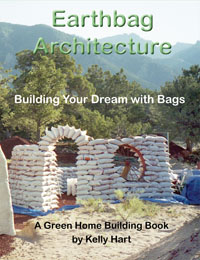EarthbagBuilding.com
Sharing information and promoting earthbag building
| Home | History | Resources | Slide Show |
| About Us | Projects | Plans | Videos |
| Blog | FAQ's | Workshops | Testing |
| Search | Articles | Bulletin Board | Shelter |
| Plastering Earthbags with Papercrete Questions answered by Kelly Hart |
Q: I read about using paper, water, and cement as a plaster. I don't know how it will withstand our termites so I will have to give it a try. A: As you may know, we used "papercrete" to plaster both sides of our domes, and it has worked out very well. Papercrete is basically made with water, paper and Portland cement, but the paper is turned back into a pulp in the process of mixing so that nothing is readable any more. A more durable final coat can be made by adding quite a bit of sand to the mix. This material does seem to resist termites and other insects. Q: I plastered my earthbag building with papercrete. Then I left it for one year without roofing it. I am from Dar-es-Salaam in East Africa. My building is under the shade of big trees. After an annual rainfall period, I found out that the papercrete turned black in color. I have some knowledge in mushroom substrate science. When the paper in in the composition stays wet for long time it becomes a good medium for fungus to grow, which decomposes the paper. As a result, the papercrete deteriorates and becomes unsuitable. Please advice me on this problem. A: I am very sorry to hear about your problems with the papercrete. I do not advise people to use papercrete in damp or humid conditions, because of this very problem. I had a little mold form inside my earthbag/papercrete dome, which I then plastered with a thick layer of lime plaster, which took care of the problem. Another possibility would be to kill the mold with bleach or something, and then replaster your walls with a cement stucco. Q: Will papercrete work on a 45 degree slope? My current design is a scoria-filled earthbag pithouse with a 45 degree roof. It's not a matter of getting it to bond like on a ceiling, but rather if it will hold up to the weather and keep water out. This design is only for dry climates. Q: In the mix of paper with cement what was is the rough percentage of cement for papercrete? A: Basically the mix that I use mostly is: 50/50 paper and cement by dry weight, and the amount of water doesn't really matter...just enough to make the slurry. This is for "pure" papercrete, without sand. For a more durable product that doesn't shrink as much and is less likely to burn, add some sand to the mix, and reduce the amount of paper proportionally by wet volume. It is best to experiment and come up with a mix that works for what you are doing. Q: For stuccoing walls, it seems to me that paper and cement mix does not get wasted as much as a mix of fine earth and cement. Although not a major cost, we have to throw a couple of layers of mix in our Hawaiian dome after some of the mix just does not hold on the wall. Seems like a crafts and artist job, the better with your hands the less waste you get. A: Yes, it is a tricky business getting plaster to stick, especially to the inside of domes. I finally came up with a technique of throwing just a thin layer of papercrete on the bags at first, and then adding more after it set up. Pure stucco is much heavier, and so even more difficult to make stick. Q: Can you tell me how thick the layer of papercrete is over your house? Is it easy to keep warm? A: Both the dome and the vaulted earthbag structures that I built have an average of about two inches of papercrete covering them. They have since been stuccoed because the papercrete was eroding in the weather after about a decade. The earthbags themselves were filled with insulating volcanic stone, so the entire envelope was very insulating and easy to keep warm. Q: How has the papercrete plaster on your earthbag house stood the test of time? A: Overall, the structure is as sound as the day I finished it. I'm sure there were also a few cracks in the PC plaster that developed over time, but I never worried much about them because of the nature of the wall system employed. |
See Your Ad |
Disclaimer of Liability and Warranty
We specifically disclaim any warranty, either expressed or implied, concerning the information on these pages. No one associated with this site will have liability for loss, damage, or injury, resulting from the use of any information found on this or any other page at this site.
For Email contact go to About Us
We are interested in communication from others who are exploring the possibilities inherent with earthbag building.
Visit Our Other Websites:
www.greenhomebuilding.com
www.dreamgreenhomes.com
www.naturalbuildingblog.com
